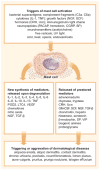Neuroimmunology of stress: skin takes center stage
- PMID: 16845409
- PMCID: PMC2232898
- DOI: 10.1038/sj.jid.5700104
Neuroimmunology of stress: skin takes center stage
Abstract
Like few other organs, the skin is continuously exposed to multiple exogenous and endogenous stressors. Superimposed on this is the impact of psychological stress on skin physiology and pathology. Here, we review the "brain-skin connection," which may underlie inflammatory skin diseases triggered or aggravated by stress, and we summarize relevant general principles of skin neuroimmunology and neuroendocrinology. Specifically, we portray the skin and its appendages as both a prominent target of key stress mediators (such as corticotropin-releasing hormone, ACTH, cortisol, catecholamines, prolactin, substance P, and nerve growth factor) and a potent source of these prototypic, immunomodulatory mediators of the stress responses. We delineate current views on the role of mast cell-dependent neurogenic skin inflammation and discuss the available evidence that the skin has established a fully functional peripheral equivalent of the hypothalamic-pituitary-adrenal axis as an independent, local stress response system. To cope with stress-induced oxidative damage, the skin and hair follicles also express melatonin, probably the most potent neuroendocrine antioxidant. Lastly, we outline major, as-yet unmet challenges in cutaneous stress research, particularly in the study of the cross-talk between peripheral and systemic responses to psychological stress and in the identification of promising molecular targets for therapeutic stress intervention.
Conflict of interest statement
CONFLICT OF INTEREST: The authors state no conflict of interest.
Figures



References
-
- Aloe L, Alleva E, Fiore M. Stress and nerve growth factor: findings in animal models and humans. Pharmacol Biochem Behav. 2002;73:159–66. - PubMed
-
- Aoki E, Shibasaki T, Kawana S. Intermittent foot shock stress prolongs the telogen stage in the hair cycle of mice. Exp Dermatol. 2003;12:371–7. - PubMed
-
- Arck PC, Handjiski B, Hagen E, Joachim R, Klapp BF, Paus R. Indications for a ‘brain-hair follicle axis (BHA)’: inhibition of keratinocyte proliferation and up-regulation of keratinocyte apoptosis in telogen hair follicles by stress and substance P. FASEB J. 2001;15:2536–8. - PubMed
-
- Arck PC, Handjiski B, Kuhlmei A, Peters EM, Knackstedt M, Peter A, et al. Mast cell deficient and neurokinin-1 receptor knockout mice are protected from stress-induced hair growth inhibition. J Mol Med. 2005;83:386–96. - PubMed
-
- Arck PC, Handjiski B, Peters EM, Hagen E, Klapp BF, Paus R. Topical minoxidil counteracts stress-induced hair growth inhibition in mice. Exp Dermatol. 2003a;12:580–90. - PubMed
Publication types
MeSH terms
Grants and funding
LinkOut - more resources
Full Text Sources
Other Literature Sources
Medical

